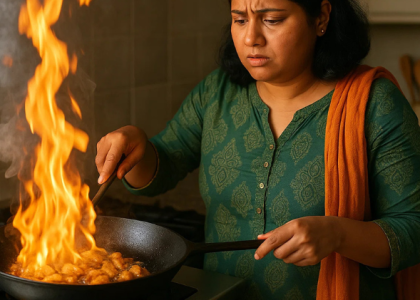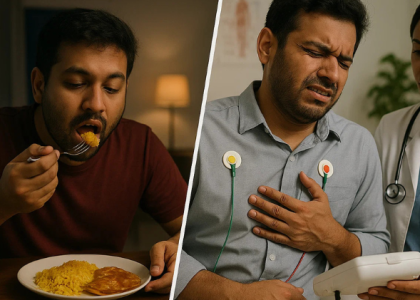Picture this: It’s a Sunday morning, and you’re enjoying a perfectly spiced masala omelet alongside a buttery paratha. The combination is delicious—crispy, rich, and satisfying. But as you take another bite, a small voice in your head whispers: “Is this good for my heart?”
If you’ve worried about eggs and heart health, you’re not alone. For decades, eggs have been caught in a tug-of-war between nutrition and concern. But recent science suggests we may have been asking the wrong question all along. It’s not just about whether you eat eggs—but how you prepare them.
What Science Really Says About Eggs and Heart Health
A landmark 2013 meta-analysis published in the British Medical Journal (BMJ) examined data from eight studies including over 3 million person-years of follow-up and thousands of heart disease cases (Rong et al., 2013). Their conclusion? Eating up to one egg per day was not associated with increased risk of coronary heart disease or stroke in the general population.
This finding contradicted decades of warnings about eggs. But there’s an important detail the researchers acknowledged: most studies didn’t account for how the eggs were cooked or what they were eaten with. And this might be where the real heart health story begins.
The Missing Piece: It’s Not Just the Egg, But Everything Around It
When we eat eggs, we rarely eat them plain. In South Asian cooking especially, eggs are transformed with:
- Oils and ghee for frying
- Spices and salt
- Accompaniments like parathas, white bread, or processed meats
- Cooking methods that may oxidize cholesterol
Dr. Frank Hu, a Harvard researcher cited in the BMJ study, noted that in many studies showing harm from eggs, the eggs were often consumed with bacon, sausage, and white toast with butter—all foods independently linked to heart disease (Hu et al., 1999).
How Cooking Methods Change Your Egg’s Heart Impact
The way you cook your egg can dramatically alter its nutritional profile and health effects:
Oxidized Cholesterol: The Hidden Risk
When eggs are cooked at high temperatures, especially when the yolk is exposed to air (like in sunny-side-up or scrambled eggs), cholesterol can become oxidized. Oxidized cholesterol is more likely to build up in artery walls than regular cholesterol (Jiang et al., 2019).
Added Fats Matter
While eggs themselves contain healthy fats, what we add during cooking can tip the balance:
- Butter and ghee add saturated fat, which can raise LDL cholesterol
- Refined vegetable oils may create inflammatory compounds when heated
- Olive oil adds heart-healthy monounsaturated fats when used in moderate amounts
Side Note: Eggs themselves don’t significantly raise blood cholesterol in most people. Your liver actually produces most of your body’s cholesterol, and when you eat more cholesterol, it often makes less to compensate (McNamara, 2000).
How South Asian Egg Preparations Stack Up
South Asian cuisines feature many beloved egg preparations—some healthier than others:
| Egg Dish | Ingredients | Heart Health Score | Why? |
| Boiled Egg | Egg only | ★★★★★ | No added fats, minimal oxidation |
| Egg Bhurji (light oil) | Eggs, vegetables, spices, small amount of oil | ★★★★☆ | Vegetables add fiber, limited oil |
| Poached Egg with Spinach | Eggs, leafy greens | ★★★★☆ | No added fat, vegetables add nutrients |
| Akuri (Parsi-style eggs) | Eggs, vegetables, moderate oil/ghee | ★★★☆☆ | Mixed – vegetables good, but may have significant added fat |
| Omelet with Cheese | Eggs, cheese, oil | ★★☆☆☆ | Added saturated fat from cheese and cooking oil |
| Fried Egg with Paratha | Egg, white flour paratha with ghee | ★☆☆☆☆ | Refined carbs, significant added saturated fat |
Making Traditional Favorites Heart-Healthier
You don’t have to give up your favorite egg dishes—just consider these modifications:
For Egg Bhurji (Scrambled Eggs):
- Use 1 tsp oil instead of 1 Tbsp
- Add more vegetables like spinach, tomatoes, and onions
- Serve with whole grain roti instead of white bread
For Anda Curry:
- Use yogurt to create creaminess instead of heavy cream
- Reduce oil by half
- Include plenty of vegetables in the curry
For Breakfast Parathas:
- Make the paratha with whole wheat flour
- Use minimal oil for cooking
- Fill with vegetables along with egg
Healthy Egg Hacks
- Hard-boil eggs in batches for quick protein-rich snacks
- Try egg whites only for some meals if watching cholesterol
- Add vegetables to every egg dish to increase fiber and nutrients
- Use non-stick pans to reduce needed cooking oil
- Try steamed eggs (like South Indian egg podimas) for a gentler cooking method
Heart-Healthy Egg Cooking Methods: Best to Worst
- Boiled: No added fat, minimal cholesterol oxidation
- Poached: No added fat, gentle cooking
- Steamed: Traditional in some South Asian dishes, gentle heat
- Scrambled with water/low-fat milk: Minimal added fat
- Baked (like frittata): Moderate heat, can control added fats
- Omelet: Can be healthy with minimal oil, but easy to overdo
- Pan-fried: Significant added fat, moderate oxidation
- Deep-fried (like egg pakoras): Highest added fat, maximum oxidation
The Whole Picture: Beyond Cooking Methods
Remember that heart health isn’t determined by single foods but by your overall eating pattern. Even the healthiest boiled egg won’t offset an otherwise unhealthy diet.
Here’s what matters most for heart health:
- Regular physical activity
- Plant-forward eating with plenty of vegetables
- Limiting processed foods
- Managing stress
- Avoiding smoking
Conclusion: Enjoy Eggs Mindfully
The science suggests that for most people, enjoying up to one egg daily is perfectly compatible with heart health. By choosing heart-friendly cooking methods and healthy accompaniments, you can continue to enjoy this nutritious food as part of your South Asian diet.
Next time you’re preparing eggs, remember: it’s not just what you eat, but how you prepare it that counts.
References:
- Rong Y, Chen L, Zhu T, et al. Egg consumption and risk of coronary heart disease and stroke: dose-response meta-analysis of prospective cohort studies. BMJ. 2013;346:e8539.
- Hu FB, Stampfer MJ, Rimm EB, et al. A prospective study of egg consumption and risk of cardiovascular disease in men and women. JAMA. 1999;281:1387–1394.
- McNamara DJ. The impact of egg limitations on coronary heart disease risk: do the numbers add up? J Am Coll Nutr. 2000;19:540S–548S.
- Jiang Z, Ahn DU, Ladner L, et al. Influence of feeding full-fat flax and sunflower seeds on internal and sensory qualities of eggs. Poult Sci. 2019;71:378–382.




